The vast land and various habitats of the North American continent enable it to boast thousands of bird species. A lot of these birds often wander away from their habitats in the trees and forests in their quest for food. They often find themselves foraging near our homes which is a pleasant surprise for people who don’t mind getting visits from these winged beauties.
There are lots of ways to attract birds to your home. The most common way is through the use of feeders. Wild animals are always on the prowl for food, and birds are no different. There are different types of feeders for birds: seed feeders, suet feeders, tube feeders, or even window feeders if you like getting greeted by birds directly at your window.
Another ornament you could add to your house to attract birds is a water source such as a bird bath. These can come in pedestal form, or you can go cheaper and just keep a plant pot around filled with clean water. A water source would even attract other cute animals, such as squirrels, to your yard.
If you live in continental North America, then you have definitely seen birds flutter in and out of your residence and would like to be able to identify some of them. Here are 15 birds that commonly visit your backyard.
1. American Robin (Turdus migratorius)
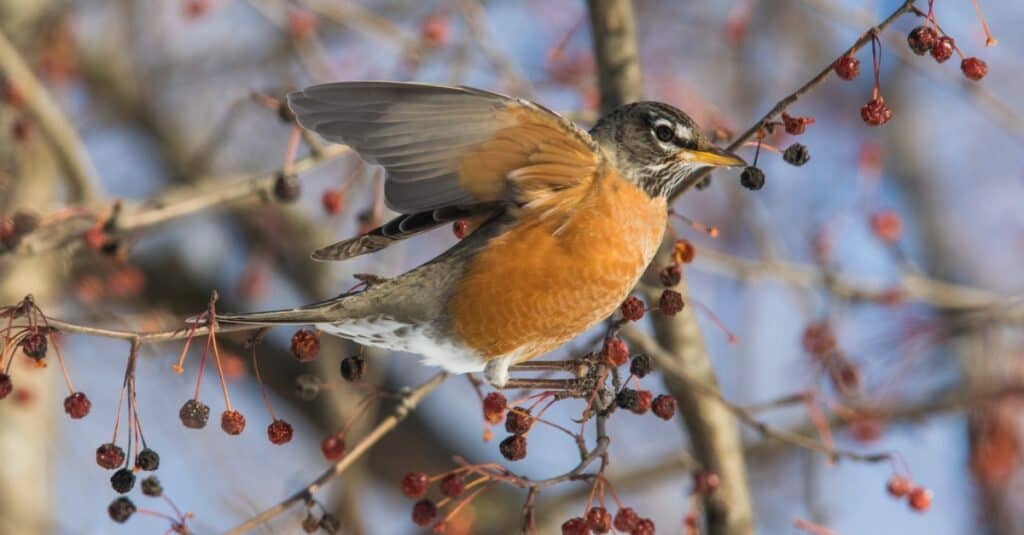
While they don’t eat seeds, American robins have been found to visit birdfeeders every once in a while.
©iStock.com/mirceax
The American robin is one of the most common birds in the United States and Canada. It is easily recognizable with its vivid red-orange belly and yellow beak. These birds eat insects, worms, and fruit. While they don’t eat seeds, they have been found to visit birdfeeders every once in a while. They do visit backyards with lawns and have been spotted hunting for worms.
If you want to entice these birds to give your backyard a visit, try setting up a birdbath or buying some mealy worms.
2. Downy Woodpecker (Picoides pubescens)

Downy woodpeckers have small, short beaks.
©Steve Byland/Shutterstock.com
The Downy woodpecker is the most abundant woodpecker in the United States, and it also happens to be the smallest. This cute bird may be small, but it can cause some raucousness when it hammers into tree bark foraging for insects and worms. They are fascinating to watch, especially when they’re hard at work. If you want to distinguish this woodpecker from other hairy woodpeckers, check its beak. Downy woodpeckers have small, short beaks. If you’re looking to attract this bird to your backyard, try getting a suet feeder. Make sure to keep the suet cake in it fresh by replacing it every so often, and you will surely catch one of these birds near your home.
3. Northern Cardinal (Cardinalis cardinalis)
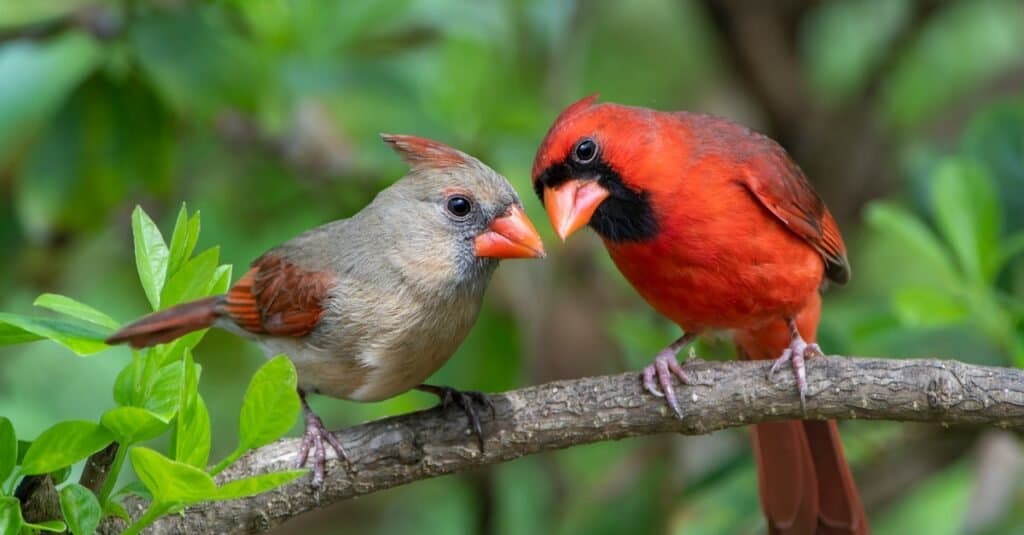
Northern cardinals consume mostly seeds as part of their diet.
©Bonnie Taylor Barry/Shutterstock.com
One of the most identifiable birds on the continent, the male Northern cardinal possesses bright red plumage, a black mask, and a regal crest. The female birds are not completely red but have grayish-tan, and red-accented wings and tails, and both sexes have chunky orange bills. If you have a backyard birdfeeder, then you’ve probably seen these red birds hanging around, especially if you add sunflower, safflower, and white milo seeds.
4. European Starling (Sturnus vulgaris)
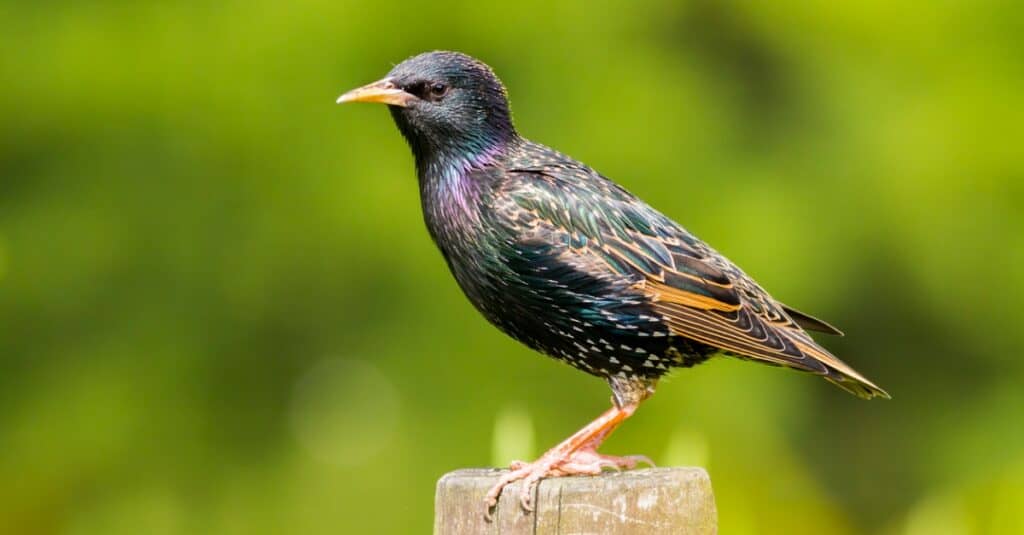
European starlings have glossy, iridescent feathers.
©iStock.com/chris2766
European starlings are definitely a beauty to behold. They may seem dark from afar, but they actually have iridescent green and purple plumage. Although these birds are aesthetically gorgeous, they are an environmental menace. Starlings can be found in every contiguous U.S. state, destroying other birds’ nests, hogging birdfeeders and not allowing other birds access, and killing their offspring. They are an invasive species and will eat just about anything. Even if you don’t want them around, they will likely show up anyway.
5. Northern Mockingbird (Mimus polyglottos)
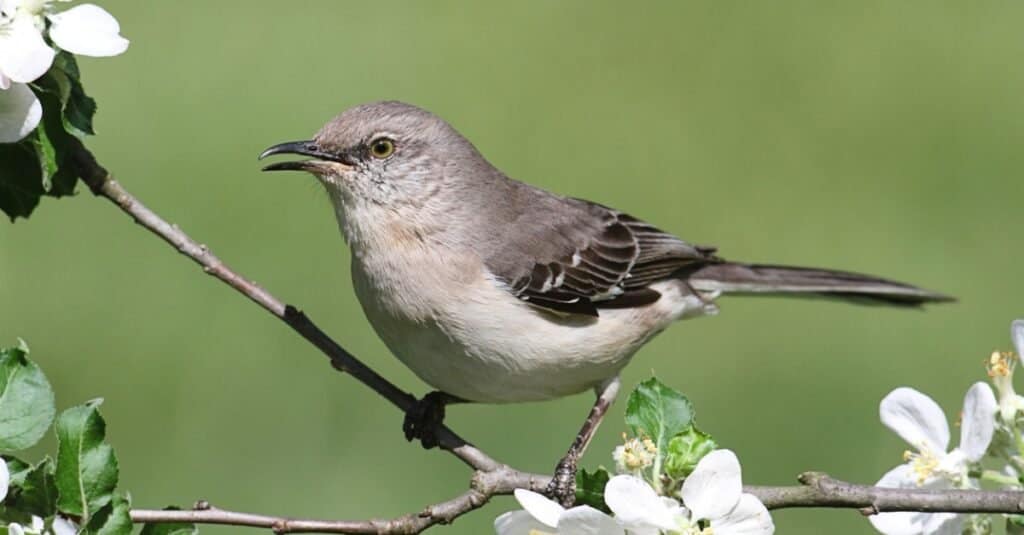
Northern mockingbirds have an uncanny ability to imitate the songs of other birds.
©Steve Byland/Shutterstock.com
Mockingbirds are prevalent throughout the United States and are notorious for their precise mimicking of sounds. Not only do they mimic other birds, but they also copy human sounds and sounds of common machinery. They can learn to mimic up to 200 different sounds.
Mockingbirds are not big-seed fans. If you want to attract these birds to your backyard, try planting berry bushes like elderberry, juniper, or even blackberries. Just don’t get too startled if they mimic your car alarm.
6. House Finch (Haemorhous mexicanus)
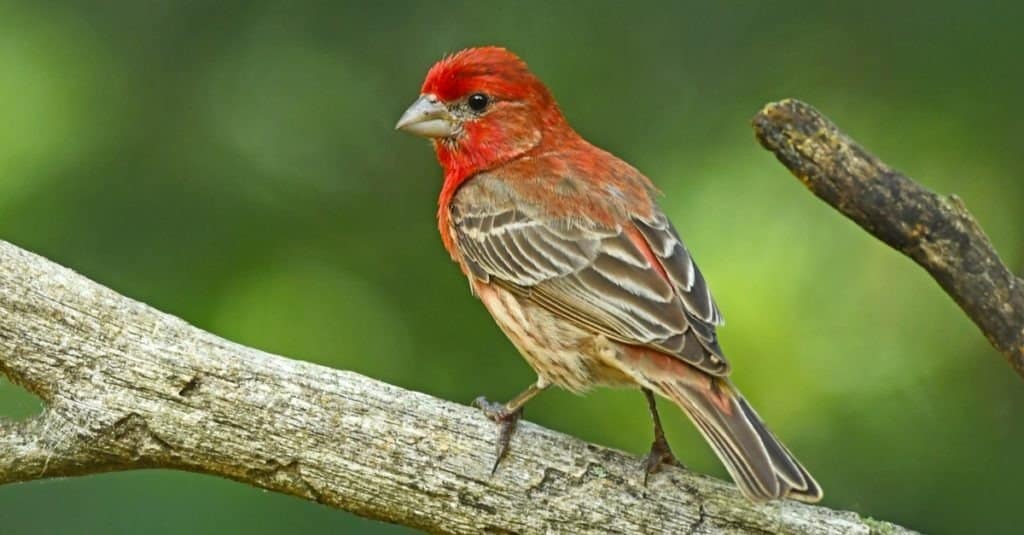
The house finch is very common and abundant across the United States.
©Brian A Wolf/Shutterstock.com
You have probably seen this bird in your backyard before. Gray and white with red plumage on the head and red splotches on its body, the house finch is very common and abundant across the United States. They visit bird feeders a lot, probably more so than any other bird. They usually arrive in small flocks. If you’re looking to attract these birds to your feeder, all you need to do is make sure the weed and sunflower seeds are plentiful. You can also add berry bushes and small flowers to the mix to really draw them in droves.
7. American Goldfinch (Carduelis tristis)
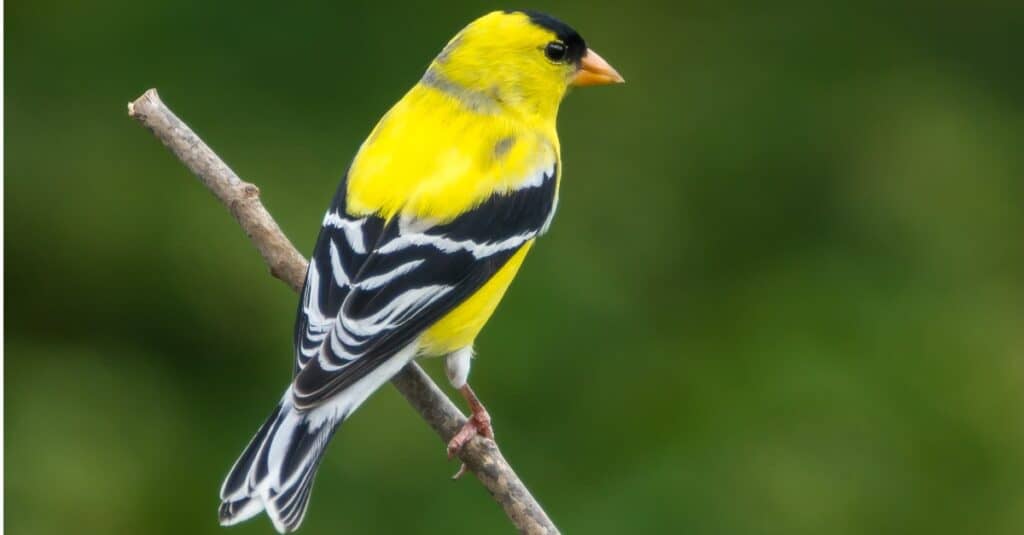
The American goldfinch averages around five inches in length.
©iStock.com/impr2003
American goldfinches are all the rage when it comes to favorite backyard birds. Who wouldn’t want to see one of these bright yellow birdies fluttering about, adding color to their yard? Male goldfinches are pleasing to look at with their yellow and black plumage. The females are less bright, with a duller olive-yellow color, but they are still very interesting to see.
These golden beauties love Niger seeds which come from the African Guizotia flower. About 86% of their diet consists of this seed. It’s a pretty easy decision to make when you think of the colorful show you’d be getting once you stock your feeder up.
8. Mourning Dove (Zenaida macroura)
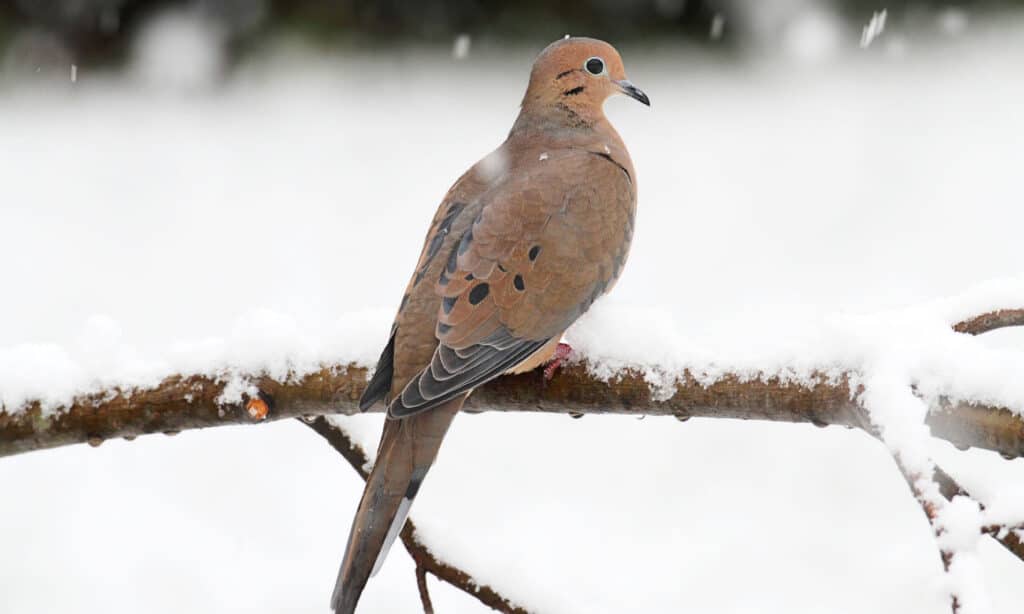
Mourning doves are the most prevalent dove in the entire North American continent.
©iStock.com/SteveByland
Mourning doves are identified by their gray plumage on top, pale underbellies, dark spots on their wings, and pointed tails. They are the most prevalent dove in the entire North American continent, so you should definitely be on the lookout for them in your backyard. They sound like owls with their “coos” that almost sound mournful, hence their name.
Mourning doves love seeds, but they prefer to forage for their food on the ground rather than pick them from a feeder.
9. Anna’s Hummingbird (Calypte anna)
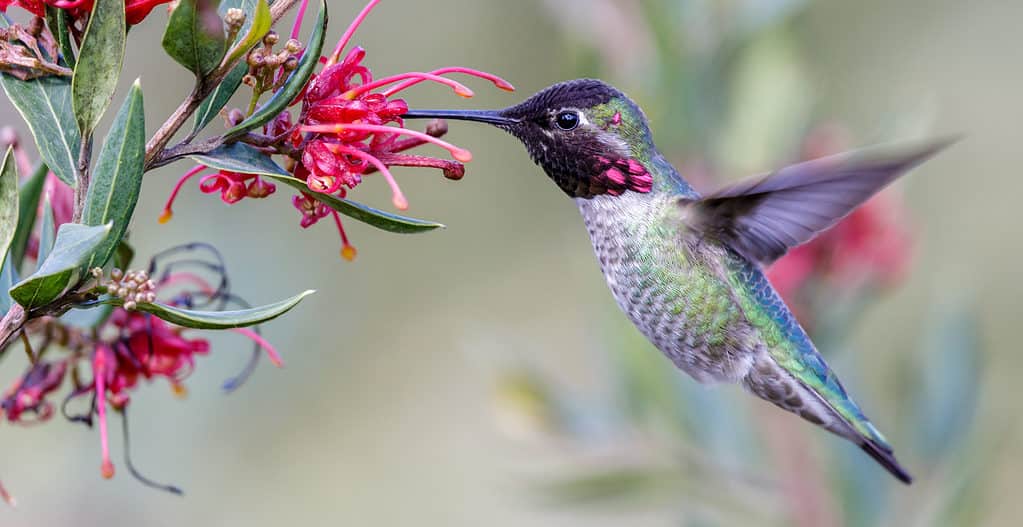
Male birds have green plumage on their bodies, pink feathers on their throat, forehead, and behind their eyes.
©yhelfman/Shutterstock.com
Hummingbirds are always pleasurable to spot because of the delicate way they hover around, as well as their unique colors. Anna’s hummingbird is no different. The male birds have green plumage on their bodies, pink feathers on their throat, forehead, and behind their eyes, and a pale breast. The females don’t typically have pink coloration, but some may have a few pink or red spots on their throats.
If you want to attract these pretty birds, try putting out a nectar feeder for them. You can also include some nectar-producing flowers and plants in your garden.
10. Red-winged Blackbird (Agelaius phoeniceus)

Red-winged blackbirds will eat seeds from your backyard feeder, and they also like to eat suet.
©iStock.com/Michael-Tatman
These attractive birds are predominant in the entire North American continent. Just as their name entails, the males are black birds with red and yellow shoulders. The females, however, are mostly brown and have pale streaks on their plumage.
These birds will eat seeds from your backyard feeder, and they also like to eat suet. Don’t be surprised when a flock of red-winged blackbirds descends on your yard. The males can bring their entire harem for the feast, which amounts to over a dozen birds.
11. House Sparrow (Passer domesticus)
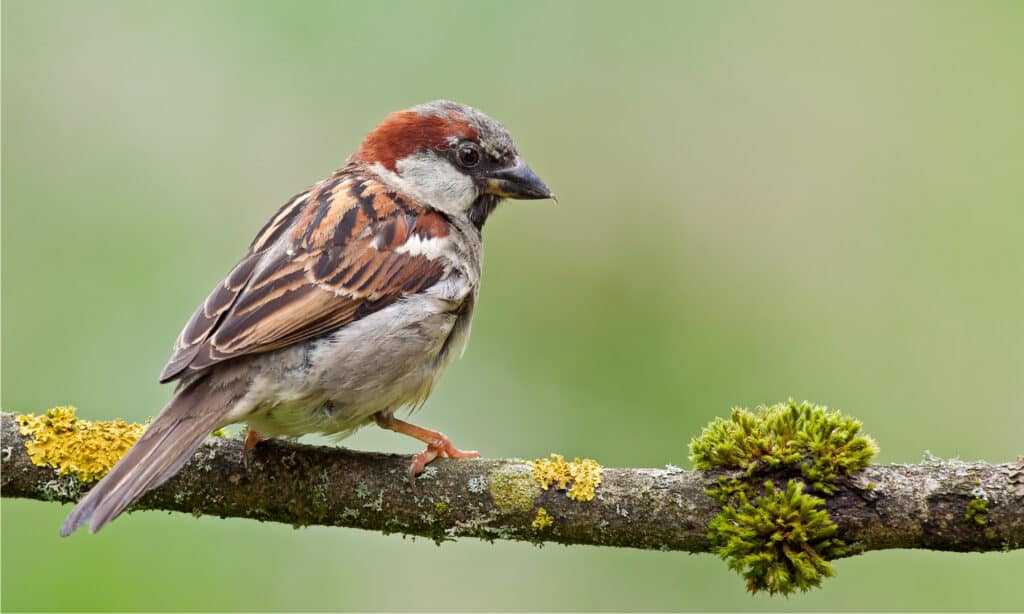
House sparrows are very common backyard visitors.
©Rob Christiaans/Shutterstock.com
House sparrows are prevalent in North America since being introduced in the 1850s. They have brown and black plumage on their bodies and a black or gray cap, pale underbellies, and dark throats. The female birds are paler than the males.
These birds are very common backyard visitors. Their favorite meal consists of seeds, so your best bet is to fill up your feeder with enough mixed seeds if you want to lure these cuties to your house. However, most people probably don’t want these birds in their area due to their being an invasive species.
12. Black-capped Chickadee (Poecile atricapillus)

Black-capped chickadees love to eat seeds, berries, suet, insects, and even peanut butter.
©Steve Byland/Shutterstock.com
If you live in the northern region of the United States, then you have probably seen this active little songbird fluttering around your yard. They have black caps and chins, and white cheeks. They love to frequent bird feeders and suet feeders. Black-capped chickadees love to eat seeds, berries, suet, insects, and even peanut butter. One thing about chickadees is that they like to store up food for later, so don’t expect them to hang around too long at your feeder.
13. American Crow (Corvus brachyrhynchos)
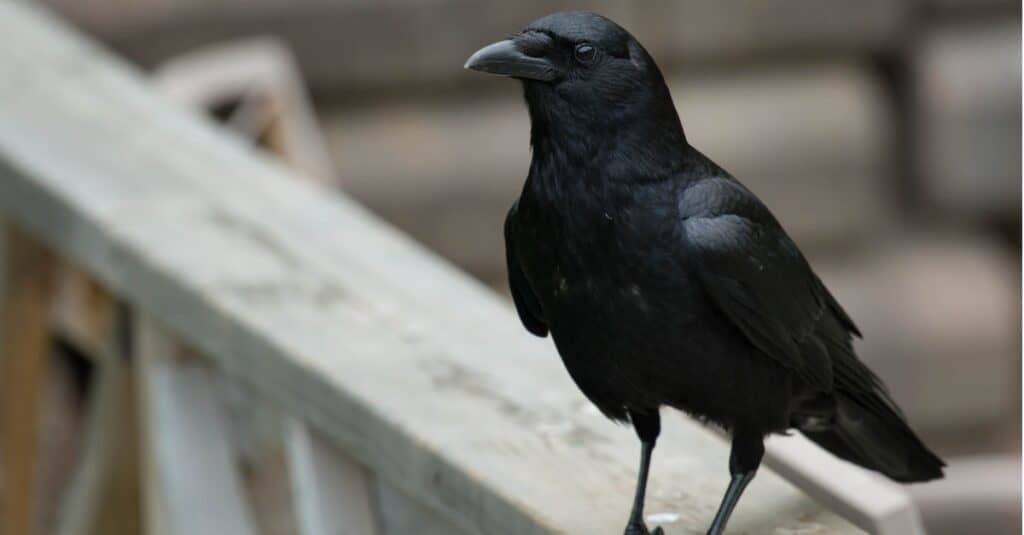
Crows are omnivores and opportunistic feeders.
©iStock.com/PaulReevesPhotography
Crows are not just easily recognized by their large size or their all-black plumage, but also from their harsh calls that sound like “caw!” These birds are also known for their intelligence which is considered to be on the same level as chimpanzees or a seven-year-old human child!
Crows are omnivores and opportunistic feeders. They eat virtually anything they can find, which includes insects, snakes, fish, human garbage, berries, nuts, and seeds. If you’re looking to have a gander at these brilliant birds, then consider sprinkling your yard with grains and seeds such as corn, sunflower seeds, nuts, and even meat scraps. These birds don’t usually eat from bird feeders.
14. Tufted Titmouse (Baeolophus bicolor)

The titmouse loves to eat sunflower seeds, peanuts, and suet.
©Rich Waite/Shutterstock.com
The tufted titmouse is known for its acrobatic moves. They hang upside down on tree branches while searching for food, such as insects and seeds. These birds regularly visit bird feeders, especially around the colder winter months when foraging in the wild gets a little tough. The titmouse loves to eat sunflower seeds, peanuts, and suet. You can identify these birds by their light blue-gray plumage and pale underbellies. Their distinguishing feature is a tufted crest on their head. The call of the titmouse sounds like it’s saying “peter-peter-peter” on repeat.
15. White-breasted Nuthatch (Sitta carolinensis)
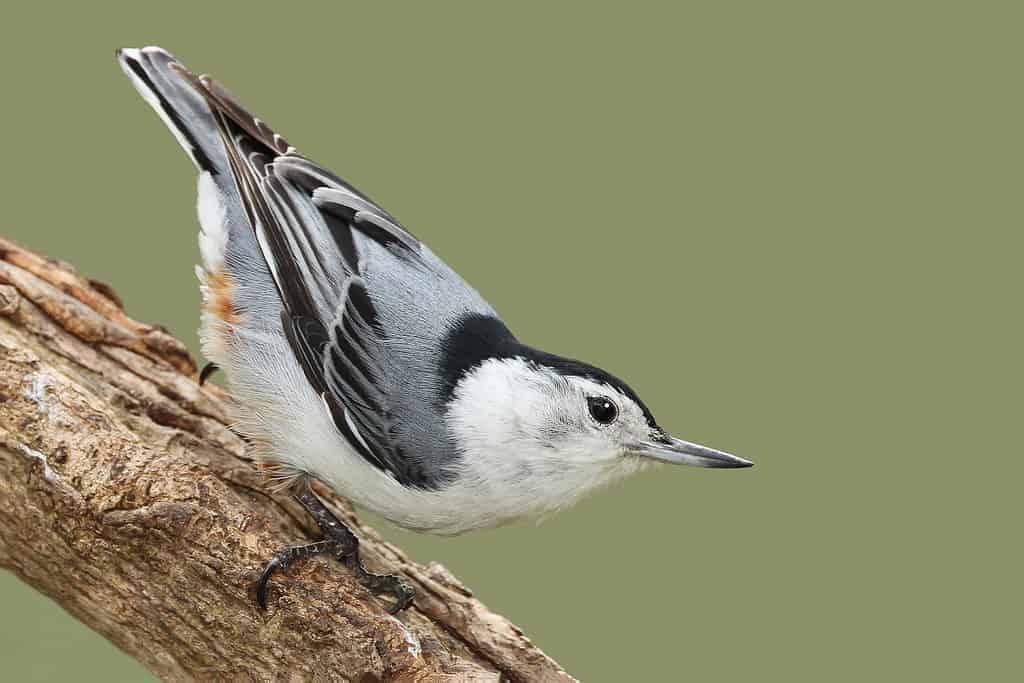
The nuthatch visits bird feeders regularly to snag some seeds and suet.
©Brian Lasenby/Shutterstock.com
The white-breasted nuthatch is another bird that prefers to hang upside down. You can recognize them from their slate-colored backs, black caps, and pale underbellies. Their calls sound like “yank-yank!”
The nuthatch visits bird feeders regularly to snag some seeds and suet. They also store their loot in trees to eat another time. These birds are common throughout much of the United States.
Summary Of 15 Common Types Of Backyard Birds
| Rank | Backyard Bird |
|---|---|
| 1 | American Robin (Turdus migratorius) |
| 2 | Downy Woodpecker (Picoides pubescens) |
| 3 | Northern Cardinal (Cardinalis cardinalis) |
| 4 | European Starling (Sturnus vulgaris) |
| 5 | Northern Mockingbird (Mimus polyglottos) |
| 6 | House Finch (Haemorhous mexicanus) |
| 7 | American Goldfinch (Carduelis tristis) |
| 8 | Mourning Dove (Zenaida macroura) |
| 9 | Anna’s Hummingbird (Calypte anna) |
| 10 | Red-winged Blackbird (Agelaius phoeniceus) |
| 11 | House Sparrow (Passer domesticus) |
| 12 | Black-capped Chickadee (Poecile atricapillus) |
| 13 | American Crow (Corvus brachyrhynchos) |
| 14 | Tufted Titmouse (Baeolophus bicolor) |
| 15 | White-breasted Nuthatch (Sitta carolinensis) |
The photo featured at the top of this post is © Rabbitti/Shutterstock.com
Sources
- American Bird Conservancy, Available here: https://abcbirds.org/blog/backyard-birds/
- The Nature Conservancy, Available here: https://www.nature.org/en-us/about-us/where-we-work/priority-landscapes/great-lakes/stories-in-the-great-lakes/midwest-backyard-birds/
- National Audubon Society, Available here: https://www.audubon.org/news/get-know-these-20-common-birds
Thank you for reading! Have some feedback for us? Contact the AZ Animals editorial team.






